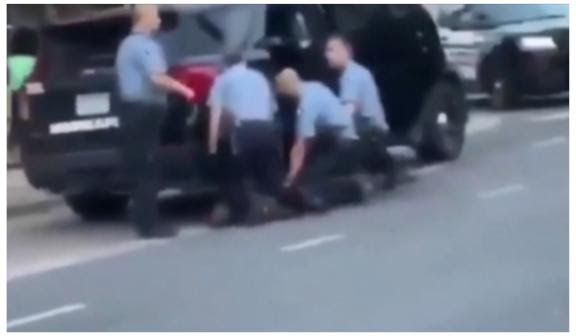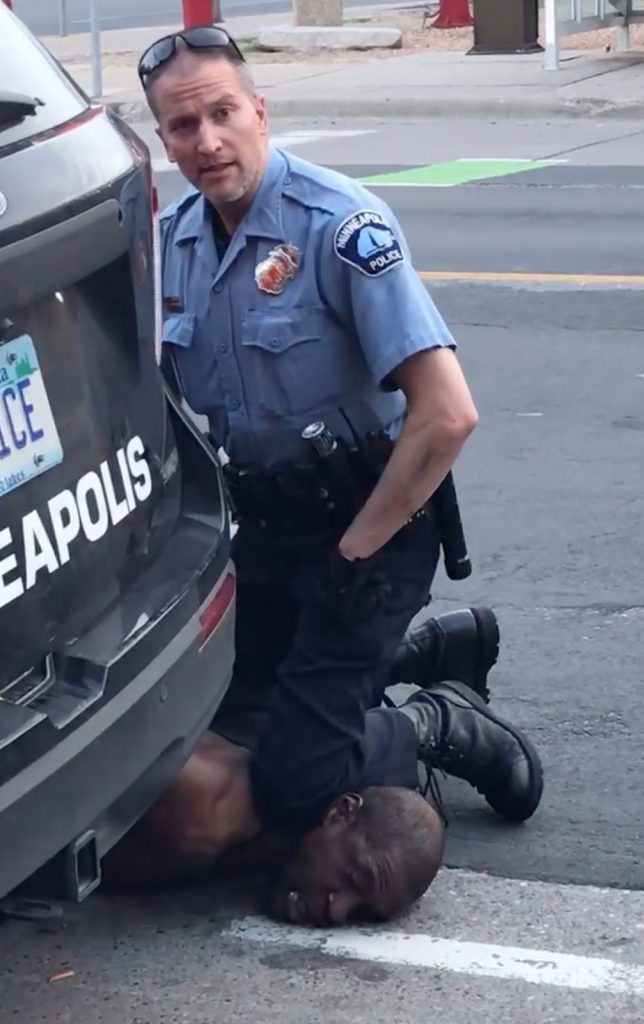Whenever the cops kill an innocent black man…
they always say the same thing.… “It’s not most cops. It’s just a few bad apples.” Bad apple? That almost sounds nice. I’ve had a bad apple. It was tart. But it didn’t choke me out.
Here’s the thing. I know it’s hard being a cop. They put their life on the line on a daily basis. I know that shit’s dangerous. But some jobs can’t have bad apples. Some jobs, everybody gotta be good. Like… pilots. You know? United Airlines can’t be like, “Most of our pilots like to land. We just got a few bad apples… that like to crash into mountains. Please bear with us.”
In George Floyd’s case, there were 4 bad apples. These were 4 too many. The scary thing is most police departments are littered with rotten apples who never get fired until they kill an innocent person and it receives national attention.
Two of the officers had multiple complaints filed against them that they were disciplined for. That means they violated their own police procedure and broke the law. Police officers accuse people of breaking the law. What about when police officers break the law? Who do you call when the police murders?
Police officers have “qualified immunity” that protects them from being sued for wrongdoing that they do when on the job. So far, courts have let police off the hook unless their behavior violated “clearly established” laws or constitutional rights. Does this extend to an unjustified killing on the job?
Let’s look at the Fourth Amendment of the US Constitution. People are guaranteed the right against “unreasonable search and seizures” and this right “shall not be violated.” An arrest is most certainly a seizure. Let’s look at whether an officer putting his knee on George’s neck was “unreasonable” by Minnesota law.
Minnesota Statute §609.066 states:
The use of deadly force by a police officer in the line of duty is justified only when necessary:
- To protect the police officer from great bodily harm;
- To arrest a person whom the police officer knows has committed a felony involving deadly force, or
- To arrest a person if the officer reasonably believes that the person will cause great bodily harm if the person’s apprehension is delayed.
There was one officer pinning George’s legs together, one officer with a knee in George’s back. With George in the most submissive position a person can be in, there is no way the third officer’s knee was necessary to protect any officer from bodily harm.
George had no weapons and was not accused of anything besides a non-violent offense of using possible counterfeit money.
George was already handcuffed before he was thrown to the pavement. So there is no way the officer can later claim he was in danger of getting hurt by George, especially when George was already pinned to the ground by two other officers.
The Minneapolis Police Department Policy & Procedure Manual provides the rules on police conduct on use of force.
They define two types of resistance.
- Active Aggression: Behavior initiated by a subject that may or may not be in response to police efforts to bring the person into custody or control. A subject engages in active aggression when presenting behaviors that constitute an assault or the circumstances reasonably indicate that an assault or injury to any person is likely to occur at any moment.
- Active Resistance: A response to police efforts to bring a person into custody or control for detainment or arrest. A subject engages in active resistance when engaging in physical actions (or verbal behavior reflecting an intention) to make it more difficult for officers to achieve actual physical control.
- Passive Resistance: A response to police efforts to bring a person into custody or control for detainment or arrest. This is behavior initiated by a subject when the subject does not comply with verbal or physical control efforts, yet the subject does not attempt to defeat an officer’s control efforts.
George cannot fall into the Active Aggression nor Active Resistance category. He already had one officer pinning his legs and another officer kneeing his back. It can be argued that because George was not complying with officer’s commands to get in the back of the police car, he was Passively Resisting.
The Procedure Manual defines two types of neck restraints.
- Conscious Neck Restraint: The subject is placed in a neck restraint with intent to control, and not to render the subject unconscious, by only applying light to moderate pressure.
- Unconscious Neck Restraint: The subject is placed in a neck restraint with the intention of rendering the person unconscious by applying adequate pressure.
These are their rules on when each type of neck restraint is justified.
- Conscious Neck Restraint may be used against a subject who is actively resisting.
- Unconscious Neck Restraint shall only be applied in the following circumstances:
- On a subject who is exhibiting active aggression, or
- For life saving purposes, or
- On a subject who is exhibiting active resistance in order to gain control of the subject; and if lesser attempts at control have been or would likely be ineffective.
Officer killed him, so no way he was trying to save his life. George was not being aggressive. To the contrary, he was pleading with the officer to let him breathe. The officers cannot say they need to gain control of George. They had 2 officers pinning him on the ground. Therefore, Officer Chauvin was prohibited from suffocating George to death with his knee.
- Neck restraints shall not be used against subjects who are passively resisting as defined by policy.
There was one officer pinning George’s legs together, one officer with a knee in George’s back. With George in the most submissive position a person can be in, there is no way he was actively resisting.
Even if George was passively resisting (which we don’t concede), neck restraints are clearly prohibited by the Department’s Procedure Manual.
Ignorance of the law is not a defense for normal people in Minnesota. So when a police officer breaks the law, shouldn’t they be held more accountable for their actions?
In 1994, Anthony Baez was choked to death by police officers. In 2014, Eric Garner was choked to death by police officers. In 2020, George Floyd was suffocated to death by police officers forcefully kneeling on his back and fatally kneeling on his neck for more than 8 minutes. The buck stops here. The era of using the veil of officer safety to excuse police officer misconduct is no longer acceptable. What about civilian safety from the police? One change that must happen today is to ban police officers from ever using their knees or any form of suffocation during an arrest.

